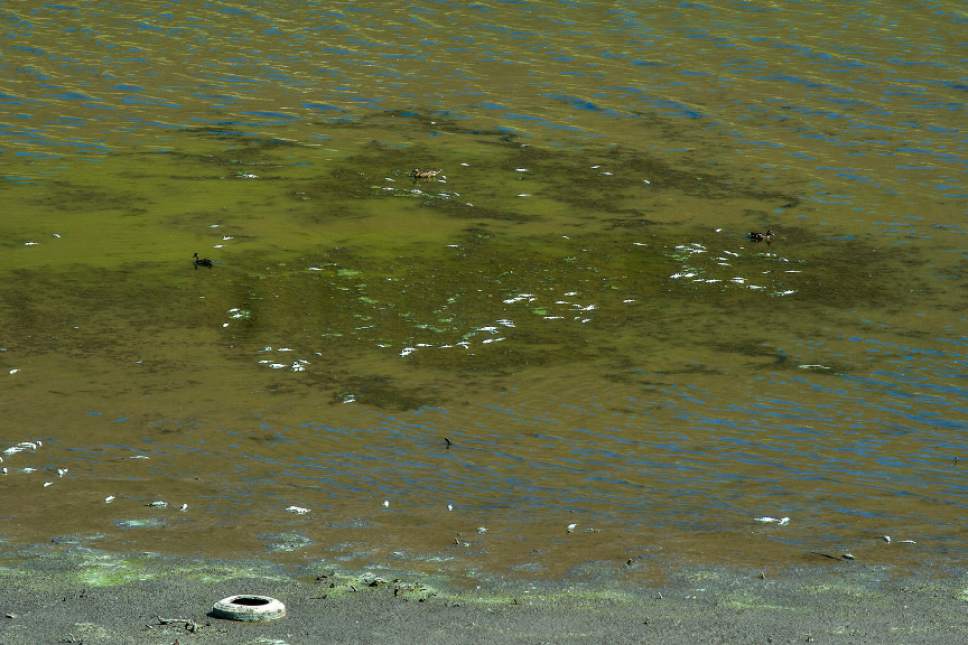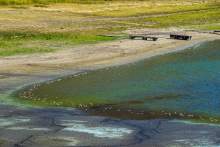This is an archived article that was published on sltrib.com in 2017, and information in the article may be outdated. It is provided only for personal research purposes and may not be reprinted.
Utah is better prepared to respond to algal blooms if the state sees a repeat of last summer's infestations on Utah Lake and Scofield Reservoir, officials said Tuesday — but how to prevent recurrences remains a hot topic of debate.
It's unclear whether large algal blooms will return to Utah's waters this year, said Erica Gaddis, newly appointed director of the state Division of Water Quality.
The winter's sizable snowpack should have filled Utah's lakes and reservoirs with cold water. Algal blooms are more likely to occur in shallow, warmer water.
But rapid spring runoff could have flushed more nutrients into Utah's waterways, which could serve as food for algae.
"How that balances out, we will see this summer," Gaddis told members of the Legislature's Natural Resources, Agriculture and Environmental Quality Appropriations Subcommittee on Tuesday.
The Division of Water Quality is assembling a panel that will select a group of scientists to study Utah Lake. That study is set to examine which factors drive the development of algal blooms on the lake and provide the basis for new guidelines on how much nutrient pollution is allowed.
Those recommendations could turn into state regulations for water treatment plants and other entities — if approved by the state Board of Water Quality.
Rep. Keven Stratton, R-Orem, said, in light of the potential high cost of such regulations to his constituents, he worried about legislative oversight throughout the process. Stratton acknowledged that the Board of Water Quality had statutory authority to regulate the discharge of pollutants into state waterways — but he intimated that he would seek changes to state law.
"May I suggest that maybe we look at adjusting those rules and regulations so that we can have some oversight here?" Stratton said. "I'm afraid we could really get blindsided on this issue."
Gaddis said state officials were more prepared to respond to future algal blooms. The Division of Water Quality now has an early warning system in place and can test in-house for toxins produced by cyanobacteria — the bacteria sometimes called blue-green algae that are responsible for poisonous algal blooms.
Waiting for data from out-of-state labs led to weeks of delay during last year's blooms.
"We feel ready this year," Gaddis said, "but we hope there won't be the level of algal blooms there was last year."
Gaddis told state lawmakers that the spread of toxin-producing bacteria from Utah Lake throughout the Jordan River caught the state by surprise and served as a "major lesson" about the interconnectedness of waterways in the Salt Lake and Utah valleys. That algal bloom lasted for three months.
Gaddis said she believed human activity was responsible for the size and duration of the Utah Lake bloom.
"The kind of algal bloom we saw on Utah Lake last year can't really be sustained without an outside source of nutrients going into the lake," she told lawmakers.
The bloom on Carbon County's Scofield Reservoir, Gaddis said, was the year's worst in terms of actual toxin concentrations.
Officials don't know whether the fish death in that reservoir was a result of the toxins, she said, but dead birds and bats found near the reservoir had high levels of microcystin, a liver toxin made by some species of cyanobacteria, in their blood, she said.
Twitter: @EmaPen









